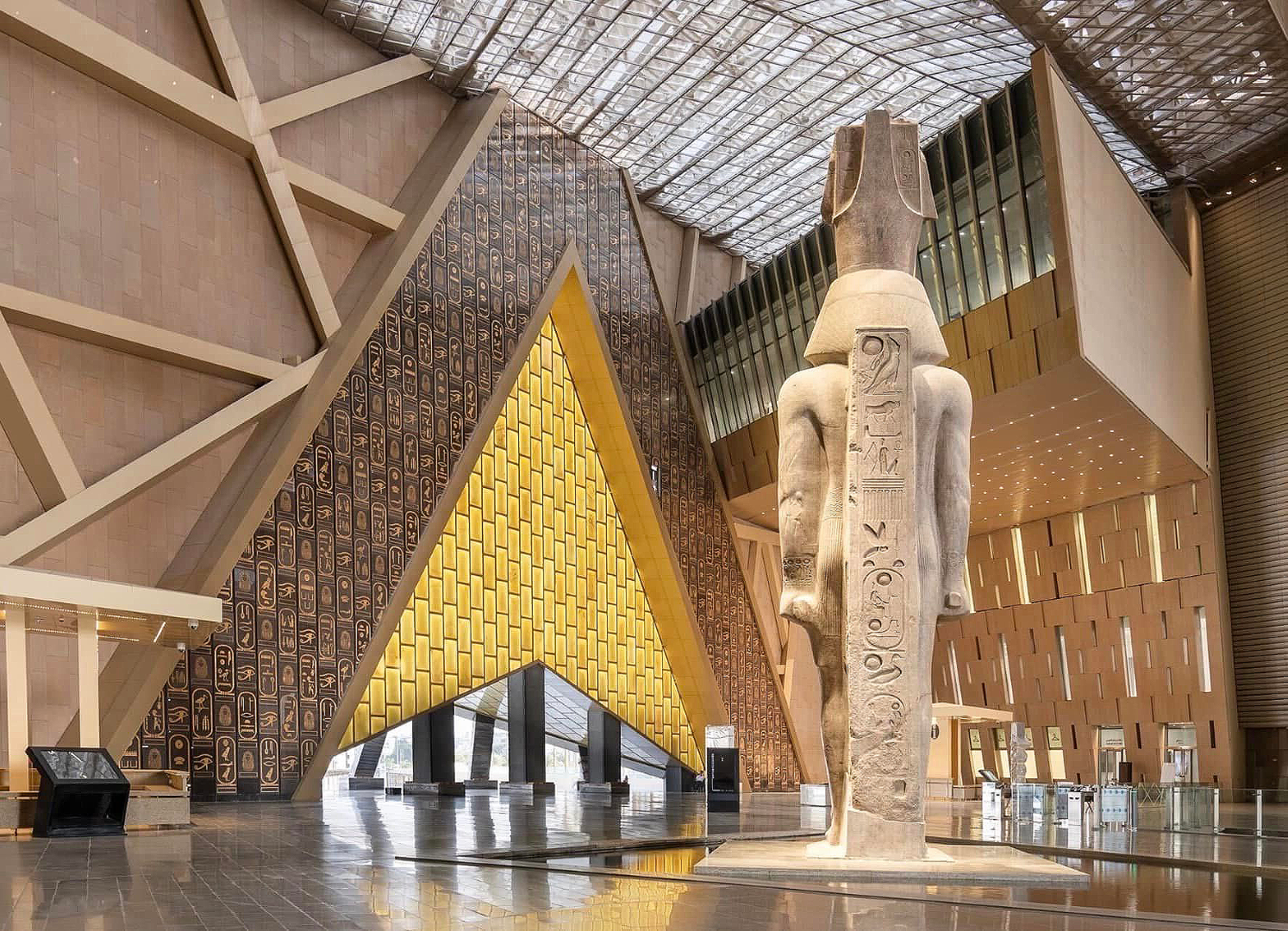Egypt has unveiled a landmark that has been two decades in the making. The Grand Egyptian Museum (GEM), located beside the Giza Pyramids, has finally opened its doors. With its launch, Egypt has not simply added another site to its long list of attractions, it has redefined Giza’s role in global tourism and marked the beginning of a new chapter for Egyptian heritage, urban planning, and cultural economy.
A Project Years in the Making
The Grand Egyptian Museum sits two kilometres from the Great Pyramid of Khufu, a position chosen to link ancient civilisation with modern Egypt. Now fully operational, it stands as the largest archaeological museum in the world dedicated to a single civilisation. The museum displays more than 100,000 artefacts, including the complete collection of Tutankhamun’s treasures shown together for the first time.
The project faced delays since construction began in 2002, but its ambition never diminished. Backed by international funding and designed by Heneghan Peng Architects, the museum’s architecture opens toward the pyramids, connecting interior halls with panoramic desert views. Inside, climate-controlled galleries, digital interpretation, and state-of-the-art conservation labs elevate Egypt’s heritage presentation to global standards.
Preparing Giza for a Global Audience
The opening of the museum brought significant change to Giza outside its walls. To manage the surge of tourists, roads leading to the Pyramids Plateau were widened, signage and lighting were updated, and new transportation options were implemented. Nearby hotels, the museum, and the plateau are now connected by shuttle buses. Pedestrian access was rearranged and security systems were updated to facilitate easier movement between attractions.
The Ministry of Tourism in Egypt is working to make Giza a world-class cultural district, and these projects are part of that effort. To enhance sustainability and the visitor experience, the Sphinx Plaza underwent renovations, landscaping was redesigned, and utilities were updated. Millions of commuters and tourists will soon be able to travel faster thanks to the Cairo Metro’s new Line 4, which is currently under construction and will connect downtown Cairo directly to the Pyramids and GEM station.
Urban Uplift Beyond Tourism
This investment is already impacting Giza’s daily life. Residents’ mobility and safety have increased thanks to new transit connections, cleaner public spaces, and better roads. New hotels, eateries, and small businesses are opening up in the surrounding neighbourhoods to cater to tourists. While commercial developers are considering mixed-use projects that integrate retail, cultural, and hospitality amenities, older buildings close to the plateau are being restored.
These urban shifts point to a larger vision. Giza is moving from being a suburb that hosted monuments to becoming a cultural city in its own right. The opening of the Grand Egyptian Museum is expected to catalyse real estate interest similar to what downtown Cairo experienced during the 2019 revitalisation wave. Analysts anticipate the museum to attract several million visitors annually, which will naturally raise demand for accommodation, retail, and services nearby.
A New Chapter for Egypt’s Tourism
Tourism contributes more than 10 percent of Egypt’s GDP and remains one of its most resilient sectors. With global travel recovering and demand for cultural destinations rising, the timing of the museum’s completion was ideal. The Grand Egyptian Museum offers a focal point around which Egypt can reposition its tourism narrative — from single-site visits to extended cultural journeys that include Cairo, Luxor, Aswan, and the Red Sea.
The museum is already promoting longer visitor stays and higher visitor spending by housing such a large collection under one roof. Tour companies have begun creating new itineraries that incorporate the pyramids, GEM, and other archaeological sites into multi-day packages. This could result in a large rise in per-visitor income for Egypt’s tourism sector as well as the creation of jobs in the travel, hospitality, and heritage industries.
Cultural Impact and National Identity
There is also symbolic significance to the Grand Egyptian Museum. It offers an up-to-date perspective on Egypt’s ancient past that showcases both technical prowess and national pride. The structure itself serves as a link between the past and the present because it is made of local limestone. It signals that Egypt is a nation investing in innovation, conservation, and environmentally friendly travel in addition to being the steward of its ancient legacy.
Inside the museum, interactive exhibits and digital reconstructions bring archaeological discoveries to life. This approach aims to make heritage more accessible to young Egyptians and international audiences who expect immersive experiences. For schools and universities, GEM now serves as a learning hub, offering education programmes and research facilities that connect historical knowledge with modern science.
Comparing Giza’s Future with Other Cultural Hubs
Global tourism has shown how a single landmark can transform an entire city. The Louvre Abu Dhabi reshaped Saadiyat Island’s identity, and the Acropolis Museum helped revive Athens’ tourism economy. The Grand Egyptian Museum could do the same for Giza.
Unlike Cairo’s Egyptian Museum in Tahrir Square, GEM’s scale allows full storytelling. It situates ancient Egypt within its original landscape, encouraging tourists to spend more time near the pyramids rather than viewing them as a half-day excursion. With new hotels and improved transportation, Giza may soon attract cultural travellers who stay multiple nights rather than a single afternoon.
Challenges Ahead
How well the momentum is maintained will determine whether this transformation is successful. The surrounding infrastructure needs to be kept tidy, secure, and properly maintained. If left unchecked, traffic jams, unofficial trade, and excessive tourism could damage the new reputation. Coordination between community stakeholders, private investors, and local government will be necessary to maintain visitor satisfaction.
Finding a balance between local demands and international expectations is another difficulty. These improvements must continue to benefit the hundreds of thousands of people who live in Giza. Better services, not job displacement or increased living expenses, should result from the growth of tourism. When properly handled, GEM can show how cultural investment can benefit not just tourists but the entire city.
The Broader Outlook for Egypt
Beyond Giza, the Grand Egyptian Museum positions Egypt more competitively within international tourism. Regional destinations such as Saudi Arabia’s AlUla and Jordan’s Petra are investing heavily in heritage-based travel. GEM gives Egypt a renewed platform to lead this segment, supported by its unmatched archaeological depth.
Combined with digital marketing, visa reforms, and improved airline connectivity, the museum’s opening could help Egypt reach its goal of attracting 30 million tourists annually within the next decade. The synergy between Cairo, Giza, and the Red Sea resorts creates a more balanced national tourism circuit that can withstand seasonal shifts and diversify income sources.
Conclusion
The opening of the Grand Egyptian Museum is more than a cultural event. It is an urban and economic turning point for Giza and a statement of Egypt’s long-term vision. The investment in infrastructure, public transport, and heritage presentation shows a country ready to re-introduce itself to the world. As visitors continue to step inside, they see not only relics of an ancient civilization but also evidence of a modern nation shaping its future through its past.



